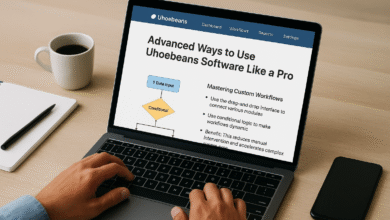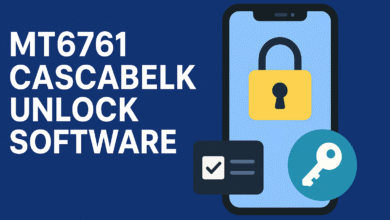How to Develop Oxzep7 Software: Your Blueprint to Building Scalable AI-Powered Productivity Platforms

In a world that moves at digital speed, businesses demand tools that are not only fast and efficient but also smart and scalable. That’s exactly where Oxzep7 software fits in—a next-generation productivity suite that combines automation, artificial intelligence, and seamless integration. If you’re planning to develop Oxzep7 software, this guide outlines everything from ideation to deployment, ensuring you’re prepared to create a tool that empowers teams and transforms workflows.
What is Oxzep7 Software?
Oxzep7 is an all-in-one productivity and workflow optimization platform built to meet the diverse needs of modern organizations. It leverages AI and modular architecture to offer scalable and secure tools tailored to sectors like healthcare, education, tech startups, and finance. Built primarily with Python, the software excels at third-party integration, offering plug-and-play support for applications like Trello, Slack, and Microsoft Teams.
Key Features of Oxzep7
Before diving into how to develop Oxzep7 software, understanding its core components is crucial:
AI-based task automation
-
Real-time team collaboration
-
Modular, scalable architecture
-
Advanced data security (encryption, 2FA, RBAC)
-
Multi-platform support (Windows, macOS, Linux)
-
Built-in APIs for external tool integration
These features serve as the foundation for development and influence every step of your build.
Step-by-Step Process to Develop Oxzep7 Software
1. Requirement Analysis and Planning
Start by identifying the specific productivity gaps your software will address. Create detailed user personas, draft user stories, and map out expected user interactions. This phase should clarify:
-
User pain points
-
Business goals and KPIs
-
Market gaps and competitive advantages
2. Choose Your Tech Stack Wisely
To develop Oxzep7 software, your stack should support modularity, scalability, and rapid development. Recommended choices:
-
Frontend: React.js, Angular, or Vue.js
-
Backend: Django or Flask (Python-based frameworks)
-
Database: PostgreSQL for relational data, MongoDB for NoSQL
-
Cloud & DevOps: AWS or Google Cloud with Docker, Jenkins, and Kubernetes for CI/CD and orchestration
3. System Architecture Design
A microservices architecture is optimal for Oxzep7. Unlike monolithic structures, microservices enable:
-
Independent deployment and updates
-
Easier scaling and resource allocation
-
Isolated failure handling
Each feature—like messaging or task tracking—can operate as an independent service connected via APIs.
4. Database Design Strategy
Focus on designing a schema that can:
-
Handle real-time data flow
-
Ensure encrypted, secure storage
-
Support analytics and reporting modules
Use indexing, proper relationship mapping, and data normalization techniques to boost performance.
5. Security Protocols
When you develop Oxzep7 software, don’t compromise on security. Must-haves include:
-
Role-based access control (RBAC)
-
Two-factor authentication (2FA)
-
End-to-end encryption
-
Compliance with GDPR, HIPAA, or relevant standards
-
Daily automated backups
6. Build Functional Modules
Break the software into core modules:
-
User Management
-
Task and Workflow Automation
-
Dashboard and Reports
-
Communication Tools (Chat, Video)
-
Integration Modules for Slack, Zoom, and Dropbox
Release MVPs of each using agile sprints, allowing room for iteration and user testing.
7. Leverage AI & Machine Learning
AI is a game-changer in Oxzep7. Integrate:
-
NLP (Natural Language Processing) to convert text into tasks
-
ML models for predictive task suggestions and data insights
-
AI bots to guide users and perform actions autonomously
Utilize tools like TensorFlow, PyTorch, and spaCy to expedite development.
8. Focus on UX & Frontend
Create a user interface that is:
-
Mobile-friendly and responsive
-
WCAG-compliant for accessibility
-
Clean and intuitive for faster onboarding
Conduct usability tests to validate layout and navigation before final deployment.
9. Rigorous Testing & QA
Quality assurance is critical before launch. Include:
-
Unit testing for individual modules
-
Integration testing for services
-
Load testing to measure scalability
-
User acceptance testing (UAT) with feedback sessions
Automation tools like Selenium or Cypress can be used to streamline the testing cycle.
10. Deployment & Scaling
Once validated, deploy using:
-
Docker containers for isolation
-
Kubernetes for orchestrated scaling
-
Jenkins or GitHub Actions for continuous deployment
Host on AWS or Azure to ensure uptime, redundancy, and support for future scaling.
11. Post-Deployment Monitoring
After going live, use tools like:
-
Datadog or New Relic for app performance
-
Sentry or Rollbar for bug tracking
-
Google Analytics for usage metrics and behavior flow
Also, gather real-time feedback to drive the next iteration or feature release.
SEO Advantages When You Develop Oxzep7 Software
Creating and launching Oxzep7 opens several SEO opportunities:
-
Niche marketing: Target industry-specific use cases
-
Thought leadership: Publish whitepapers, tutorials, or case studies
-
Backlinking: Collaborate with tech blogs, forums, and directories to boost visibility
-
Search Optimization: Optimize metadata, headings, and alt text within the application
These efforts can bring organic traffic to your platform and increase brand awareness.
Common Challenges & How to Solve Them
Integration Overhead
Use RESTful APIs and industry-standard authentication like OAuth2 for smooth connectivity.
AI Model Performance
Continuously retrain models using fresh datasets to maintain prediction accuracy.
Data Compliance
Adopt global standards like HIPAA, SOC 2, and GDPR from day one.
Future-Ready Upgrades for Oxzep7
-
IoT Integration: Automate inputs from smart devices
-
Voice Command: Support Alexa and Siri commands
-
Blockchain: For audit trails and secure recordkeeping
-
KPI Dashboards: Custom reports with drill-down capabilities
-
Community Features: User forums and developer SDKs
Final Thoughts
To develop Oxzep7 software effectively, blend robust architecture with user-centered design and intelligent features. Whether you’re building for a startup or an enterprise, this development framework ensures your tool is secure, scalable, and future-proof.
FAQs
Q1: What sets Oxzep7 apart from other productivity tools?
Oxzep7’s AI-driven automation, flexible modular structure, and top-tier security make it more adaptable and powerful compared to most traditional tools.
Q2: Which industries benefit most from Oxzep7?
Healthcare, education, fintech, and tech startups can significantly improve workflow and collaboration using Oxzep7.
Q3: Why use microservices when you develop Oxzep7 software?
Microservices allow teams to scale, update, and maintain different modules independently, which is crucial for fast-growing platforms.
Q4: How does AI enhance Oxzep7 functionality?
AI powers smart assistants, NLP-driven task creation, and predictive analytics, offering a smarter, faster user experience.
Q5: What are the security highlights in Oxzep7?
The platform offers end-to-end encryption, role-based access, 2FA, and adheres to global compliance standards like GDPR and HIPAA.
Read also:MenBoosterMark Software Program: Your Complete Guide to This All-in-One Men’s Development Tool



